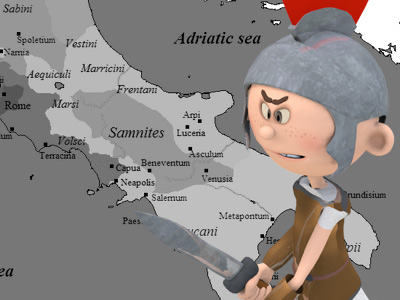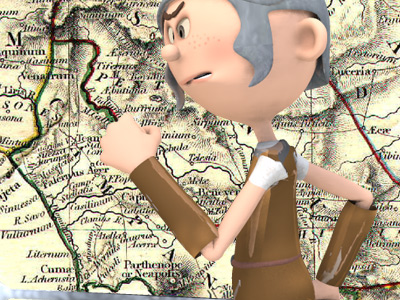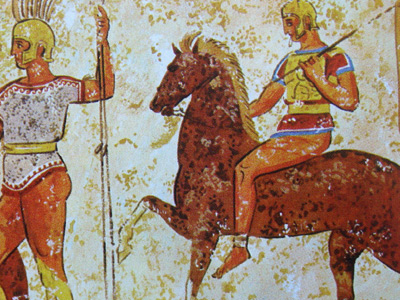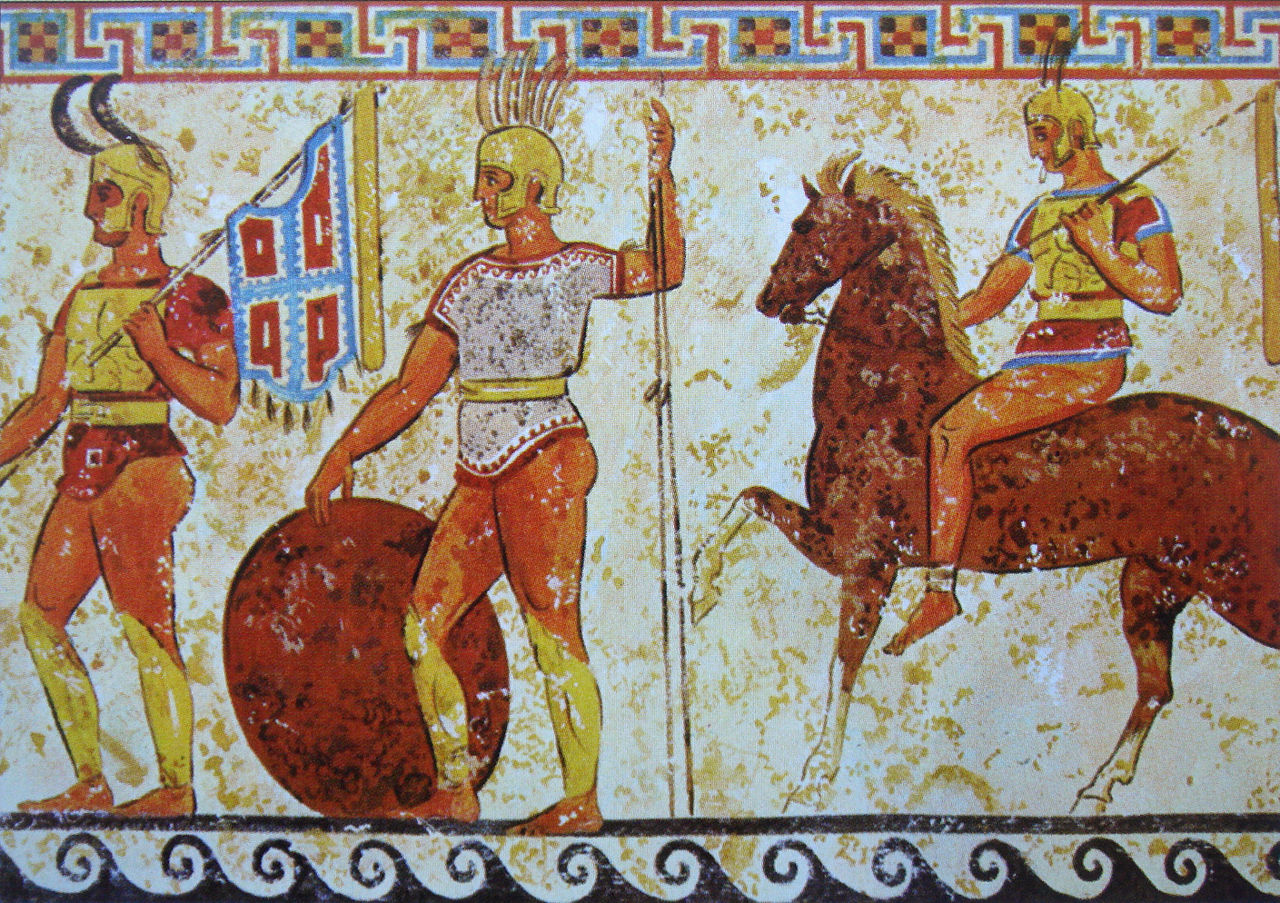First Samnite War (343-341 BC)

Outbreak
Livy's Account
According to Livy, the First Samnite War started not because of any enmity between Rome and the Samnites, but due to outside events. The spark came when the Samnites without provocation attacked the Sidicini, a tribe living north of Campania with their chief settlement at Teanum Sidicinum. Unable to stand against the Samnites, the Sidicini sought help from the Campanians. However, Livy continues, the Samnites defeated the Campanians in a battle in Sidicine territory and then turned their attention toward Campania. First they seized the Tifata hills overlooking Capua (the main Campanian city) and, having left a strong force to hold them, marched into the plain between the hills and Capua. There they defeated the Campanians in a second battle and drove them within their walls. This compelled the Campanians to ask Rome for help.
At Rome, the Campanian ambassadors were admitted to an audience with the Senate. In a speech, they proposed an alliance between Rome and the Campanians, noting how the Campanians with their famous wealth could be of aid to the Romans The Roman Republic was a form of government of Rome and the era of the classical Roman civilization when it was run through public representation of the Roman people. Beginning with the overthrow of the Roman Kingdom (traditionally dated to 509 BC) and ending in 27 BC with the establishment of the Roman Empire, Rome's control rapidly expanded during this period - from the city's immediate surroundings to hegemony over the entire Mediterranean world., and that they could help to subdue the Volsci, who were enemies of Rome. They pointed out that nothing in Rome's treaty with the Samnites prevented them from also making a treaty with the Campanians, and warning that if they did not, the Samnites would conquer Campania and its strength would be added to the Samnites' instead of to the Romans'. After discussing this proposal, the senate concluded that while there was much to be gained from a treaty with the Campanians, and that this fertile area could become Rome's granary, Rome could not ally with them and still be considered loyal to their existing treaty with the Samnites, and for this reason they had to refuse the proposal. After being informed of Rome's refusal, the Campanian embassy, in accordance with their instructions, surrendered the people of Campania and the city of Capua unconditionally into the power of Rome. Moved by this surrender, the Senators resolved that Rome's honour now required that the Campanians and Capua, who by their surrender had become the possession of Rome, be protected from Samnite attacks.
The Roman Republic was a form of government of Rome and the era of the classical Roman civilization when it was run through public representation of the Roman people. Beginning with the overthrow of the Roman Kingdom (traditionally dated to 509 BC) and ending in 27 BC with the establishment of the Roman Empire, Rome's control rapidly expanded during this period - from the city's immediate surroundings to hegemony over the entire Mediterranean world., and that they could help to subdue the Volsci, who were enemies of Rome. They pointed out that nothing in Rome's treaty with the Samnites prevented them from also making a treaty with the Campanians, and warning that if they did not, the Samnites would conquer Campania and its strength would be added to the Samnites' instead of to the Romans'. After discussing this proposal, the senate concluded that while there was much to be gained from a treaty with the Campanians, and that this fertile area could become Rome's granary, Rome could not ally with them and still be considered loyal to their existing treaty with the Samnites, and for this reason they had to refuse the proposal. After being informed of Rome's refusal, the Campanian embassy, in accordance with their instructions, surrendered the people of Campania and the city of Capua unconditionally into the power of Rome. Moved by this surrender, the Senators resolved that Rome's honour now required that the Campanians and Capua, who by their surrender had become the possession of Rome, be protected from Samnite attacks.
Envoys were sent to the Samnites with the introductions to request that they, in view of their mutual friendship with Rome, spare territory which had become the possession of Rome and, if this was not heeded, to warn them to keep their hands off the city of Capua and the territory of Campania. The envoys delivered their message as instructed to the Samnites' national assembly. They were met with a defiant response, "not only did the Samnites declare their intention of waging war against Capua, but their magistrates left the council chamber, and in tones loud enough for the envoys to hear, ordered [their armies] to march out at once into Campanian territory and ravage it." When this news reached Rome, the fetials were sent to demand redress, and when this was refused Rome declared war against the Samnites.
Modern Views
The historical accuracy of Livy's account is disputed among modern historians. They are willing to accept that while Livy might have simplified the way in which the Sidicini, Campani and Samnites came to be at war, his narrative is here, at least in outline, historical. The Sidicini's stronghold at Teanum controlled an important regional crossroads, which would have provided the Samnites with a motive for conquest. The First Samnite War might have started quite by accident, as Livy claimed. The Sidicini were located on the Samnite river side of the Liris, and while the Roman-Samnite treaty might only have dealt with the middle Liris, not the lower, Rome does not appear to have been overly concerned for the fate of the Sidicini. The Samnites could therefore go to war with Sidicini without fear of Roman involvement. It was only the unforeseen involvement of the Campani that brought in the Romans.
Many historians have however had difficulty accepting the historicity of the Campanian embassy to Rome, in particular whether Livy was correct in describing the Campani as surrendering themselves unconditionally into Roman possession. That Capua and Rome were allied in 343 is less controversial, as such a relationship underpins the whole First Samnite War.
Historians have noted the similarities between the events leading to the First Samnite War and events which according to Thucydides caused the Peloponnesian War, but there are differences as well. It is clear that Livy, or his sources, has consciously modelled the Campanian embassy after the "Corcyrean debate" in Thucydides' History of the Peloponnesian War. There are many parallels between the speech given by the Campanian ambassador to the Roman senate in Livy and the speech of the Corcyrean ambassador to the Athenian assembly in Thucydides. But while Thucydides's Athenians debate the Corcyreans' proposal in pragmatic terms, Livy's senators decide to reject the Campanian alliance based on moral arguments. Livy might well have intended his literary educated readers to pick up this contrast. The exaggerated misery of the surrendering Campani contrast with the Campanian arrogance, a stock motif in ancient Roman literature. It is also unlikely that Livy's description of the Samnite assembly is based on any authentic sources. However it does not necessarily follow that because the speeches are invented, a standard feature in ancient historians, the Campanian surrender must be invented as well.
The chief difficulty lies in how rich Capua in 343 can have been reduced to such dire straits by the Samnites that the Campani were willing to surrender everything to Rome. During the Second Punic War (218 to 201 BC) Capua famously sided with Carthage, but after a lengthy siege she had to surrender unconditionally in 211 BC, after which the Capuans were harshly punished by Rome. Salmon (1967, p. 197) therefore held that the Campanian surrender in 343 is a retrojection by later Roman historians. This invention would serve the double purpose of exonerating Rome from treaty-breaking in 343 and justifying the punishment handed out in 211. What Rome agreed to in 343 was an alliance on terms similar to the treaties she had with the Latins and the Hernici. Cornell (1995, p. 347) accepts the surrender as historical. Studies have shown that voluntary submission by one party was a common feature in the diplomacy of this period. Likewise Oakley (1998, p. 286–9) does not believe the surrender of 343 to be a retrojection, not finding many similarities between the events of 343 and 211. The ancient historians record many later instances, whose historicity are not doubted, where a state appealed to Rome for assistance in war against a stronger enemy. The historical evidence shows the Romans considered such supplicants to have technically the same status as surrendered enemies, but in practice Rome would not want to abuse would-be allies. Forsythe (2005, p. 287), like Salmon, argues that the surrender in 343 is a retrojection of that of 211, invented to better justify Roman actions and for good measure shift the guilt for the First Samnite War onto the manipulative Campani.
Livy portrays the Romans as selflessly assuming the burden of defending the Campani, but this is a common theme in Roman republican histories, whose authors wished to show that Rome's wars had been just. Military success was the chief road to prestige and glory among the highly competitive Roman aristocracy. Evidence from later, more well documented time periods shows a Roman senate quite capable of manipulating diplomatic circumstances so as to provide just cause for an expansionary war. There is no reason to believe this was not also the case in the second half of the 4th century. There are also recorded examples of Rome rejecting appeals for help, implying that the Romans in 343 had the choice of rejecting the Campani.
HISTORY
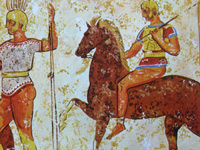
RESOURCES
This article uses material from the Wikipedia article "First Samnite War", which is released under the Creative Commons Attribution-Share-Alike License 3.0.
© Stories Preschool. All Rights Reserved.
